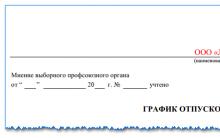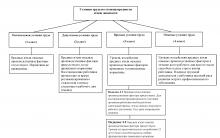Introduction
In order to successfully study the material part of the equipment of the NBC protection troops, deep knowledge of general technical disciplines is necessary. Many machine parts are subjected to cyclic stresses during operation. Therefore, cadets should have an idea about the parameters and types of stress cycles, the phenomenon and endurance limit.
Therefore, the material of this lecture is of great importance. The purpose of this lecture is to give students the basic terms and definitions related to cyclic stresses, to study the issue of calculating structural elements for strength under a given type of loading.
The concept of cyclic stresses. Parameters and types of stress cycles
Dynamic loads, despite the absence of significant inertial forces, include periodic multiple repeated (cyclic) loads acting on structural elements. This kind of loading is typical for most engineering structures, such as axles, shafts, rods, springs, connecting rods, etc.
The strength of materials under repeated-variable loading largely depends on the nature of the change in stresses over time.
- variable load with a time-established nature of change, the values of which are repeated after a certain period (period) of time.Stress cycle- the totality of all values of variable stresses during one period of load change.
Typically, a stress cycle is characterized by two main cycle parameters: and - the maximum and minimum stresses of the cycle.
Average cycle voltage ![]() .
.
Amplitude cycle voltage ![]() .
.
Coefficient of asymmetry of the stress cycle.
Depending on the magnitude of the listed characteristics, stress cycles can be divided into the following main types:
Symmetric cycle– the maximum and minimum voltages are equal in absolute value and opposite in sign, R = -1.
Asymmetric cycle- the maximum and minimum voltages are not equal in absolute value, while the asymmetric cycle can be sign-alternating or sign-constant.
alternating cycle– the maximum and minimum voltages are not equal in absolute value and opposite in sign , , .
Constant-sign cycle– the maximum and minimum voltages are not equal in absolute value and have the same sign , , .
Zero (pulsating) cycle– the maximum or minimum voltages are equal to zero or , or .
The phenomenon of fatigue. fatigue curve. endurance limit
As practice shows, loads that cyclically change in time in magnitude or in magnitude and sign can lead to structural failure at stresses significantly lower than the yield strength (or tensile strength). Such destruction is called "fatigue". The material seems to "get tired" under the action of repeated periodic loads.
fatigue failure- destruction of the material under the action of repetitively alternating stresses.
Material fatigue- gradual accumulation of damage in the material under the action of variable stresses, leading to the formation of cracks in the material and destruction.
Endurance is the ability of a material to resist fatigue failure.
The physical causes of fatigue failure of materials are quite complex and not yet fully understood. One of the main causes of fatigue failure is considered to be the formation and development of cracks.
The mechanism of fatigue failure is largely related to the heterogeneity of the real structure of materials (difference in size, shape, orientation of neighboring metal grains; the presence of various inclusions - slags, impurities; crystal lattice defects, material surface defects - scratches, corrosion, etc.). In connection with the indicated inhomogeneity at variable stresses at the boundaries of individual inclusions and near microscopic voids and various defects, a stress concentration arises, which leads to microplastic shear deformations of some metal grains, while slip bands may appear on the surface of the grains, and shear accumulation, which on some materials manifests itself in the form of microscopic tubercles and depressions - extrusions and intrusions. Then there is the development of shifts into microcracks, their growth and merging; at the last stage, one or several macrocracks appear, which develop (grow) quite intensively. The crack edges rub against each other under the action of a variable load, and therefore the crack growth zone has a smooth (polished) surface. As the crack grows, the cross section of the part weakens more and more, and finally, a sudden brittle fracture of the part occurs, while the brittle fracture zone has a coarse-grained crystalline structure, as in brittle fracture.
The fatigue curve (Weller curve) is built on the basis of the results of fatigue tests with a symmetrical cycle. It shows that with an increase in the number of cycles, the maximum stress at which the destruction of the material occurs decreases significantly. At the same time, for many materials, for example, carbon steel, it is possible to set such a maximum cycle stress at which the sample does not collapse after any number of cycles (horizontal section of the diagram), called the endurance limit ().
Limit of endurance (fatigue) is the maximum (limiting) stress of the cycle, at which there is no fatigue failure of the sample after an arbitrarily large number of cycles.
Since tests cannot be carried out indefinitely, the number of cycles is limited by a certain limit, which is called the base number of cycles. In this case, if the sample withstands the base number of cycles (for ferrous metals - N= 10 7), then it is considered that the voltage in it is not higher than the endurance limit.
Fatigue curves for non-ferrous metals do not have horizontal sections, so for them for the base number of cycles it increases to N= 10 8 and the limit of limited endurance is set.
In real structures, the vast majority of parts operate under asymmetric loading.
The ultimate stress diagram (Smith diagram) is built on at least three loading modes (three points), for each of which the endurance limit is determined.
The first mode (point 1) is the usual symmetrical loading cycle ( , , , ).
The second mode (point 2) is an asymmetric loading cycle, usually zero ( , , , ).
The third mode (point 3) is simple static stretching ( , ).
The obtained points are connected by a smooth line, the ordinates of the points of which correspond to the endurance limits of the material at different values of the cycle asymmetry coefficient.
A beam passing at an angle through the origin of the limit stress diagram characterizes cycles with the same asymmetry coefficient R :
![]() .
.
The diagram of limiting amplitudes (Haig diagram) is constructed in the coordinates: the average stress of the cycle - the amplitude of the cycle (Figure 7). At the same time, to build it, it is necessary to carry out fatigue tests for at least three modes: 1 - symmetrical cycle; 2 – zero cycle; 3 - static stretching.
Connecting the obtained points with a smooth curve, a graph is obtained that characterizes the relationship between the values of the limiting amplitudes and the values of the limiting average stresses in the cycle.
In addition to material properties, the following factors influence fatigue strength: 1) the presence of stress concentrators; 2) scale factor, that is, the influence of the absolute dimensions of the part (the larger the size of the part, the lower the fatigue strength); 3) the quality of surface treatment (with a decrease in the surface roughness of the part, fatigue strength increases); 4) operational factors (temperature, corrosion, frequency of loading, radiation exposure, etc.); 5) the presence of a surface layer hardened by various technological methods.
stress fatigue strength curve
The endurance limit is not a constant characteristic of a given material, and is subject to much greater fluctuations than mechanical characteristics under static loading. It depends on the loading conditions, the type of cycle, in particular, on the degree of its asymmetry, the shape and dimensions of the part, its manufacturing technology, the state of the surface, and other factors.
Thus, when testing for fatigue of standard samples, it is not the endurance limit of the material itself that is determined, but the endurance limit of the sample made from this material. When moving from a sample to a real part, a number of corrections should be introduced that take into account the shape and dimensions of the part, the state of its surface, etc. In connection with this, the concept of fatigue resistance of parts arose. In this understanding, the endurance limit is far from the original concept as a material characteristic, although the endurance limit determined on standard samples is still cited as one of the main strength indicators of the material.
There is also the concept node fatigue resistance(threaded connections, connections with an interference fit and other prefabricated structures). Thus, the concept of fatigue resistance includes not only factors of material properties and the geometric shape of parts, but also factors interactions with adjacent parts.
Bending endurance limits have a minimum value for a symmetrical alternating cycle, increase with an increase in the degree of its asymmetry, increase in the region of pulsating loads, and with a decrease in the amplitude of pulsations, they approach the indicators of the static strength of the material. The endurance limit in tension is approximately 1.1-1.5 times greater, and in torsion 1.5-2 times less than in the case of symmetric alternating bending.
There is no definite relationship between the characteristics of fatigue resistance and static strength. The most stable relationships exist between σ -1 (flexural endurance limit with a symmetrical cycle) and σ in (tensile strength), as well as σ 0.2 (conditional yield strength) in static tension.
According to experimental data, these ratios are as follows:
For steels

For steel castings, ductile iron and copper alloys
For aluminum and magnesium alloys
For gray cast iron
Based on the processing of fatigue test results for improved structural steels, Shimek obtained the following dependencies (Fig. 163) of endurance limits on tensile strength:

In tension-compression with a symmetrical cycle
For tension-compression with a pulsating cycle
For bending with a symmetrical cycle
For torsion with a symmetrical cycle
Torsional with pulsating cycle
![]()
Endurance limits for a symmetrical cycle are interconnected by the following approximate dependencies:
The endurance limits for pulsating and alternating symmetrical cycles are related by the following approximate dependencies.
Endurance limit(Also fatigue limit) - in the sciences of strength: one of the strength characteristics of a material that characterizes its endurance, that is, the ability to perceive loads that cause cyclic stresses in the material.
The fatigue limit is defined as the highest (ultimate) maximum cycle stress at which there is no fatigue failure of the sample after an arbitrarily large number of cyclic loadings.
The endurance limit is expressed as σ R (\displaystyle \sigma _(R)), where the coefficient R is taken equal to the cycle asymmetry coefficient r = σ m i n σ m a x (\displaystyle r=(\frac (\sigma _(min))(\sigma _(max)))) equal to the ratio of the minimum cycle stress σ m i n (\displaystyle \sigma _(min)) to the maximum σ m a x (\displaystyle \sigma _(max)). Thus, the endurance limit of the material in the case of symmetrical loading cycles is denoted as σ -1 (\displaystyle \sigma _(\text(-1))), and in the case of pulsating as 0 (\displaystyle \sigma _(0)).
It has been established that, as a rule, for steels, the bending endurance limit is half of the tensile strength:
σ -1 ≈ (0 , 4...0 , 5) σ B.P. (\displaystyle \sigma _(\text(-1))\approx (0.4...0.5)\sigma _(\text(B.P.)))
For high-strength steels, you can take:
σ -1 ≈ 400 + 1/6 σ B.P. (\displaystyle \sigma _(\text(-1))\approx 400+1/6\sigma _(\text(B.P.)))
For non-ferrous metals, you can accept:
σ -1 ≈ (0 , 25...0 , 5) σ B.P. (\displaystyle \sigma _(\text(-1))\approx (0.25...0.5)\sigma _(\text(B.P.)))
For carbon fiber, you can take:
σ -1 ≈ 0.8 σ B.P. (\displaystyle \sigma _(\text(-1))\approx 0.8\sigma _(\text(B.P.)))
Similarly, torsion tests can be carried out under conditions of cyclically changing stresses. For ordinary steels in this case, you can take:
τ -1 ≈ 0 .6 σ -1 (\displaystyle \tau _(\text(-1))\approx 0.6\sigma _(\text(-1)))
For brittle materials (high-alloy steel, cast iron), in this case, you can take:
τ -1 ≈ 0 .8 σ -1 (\displaystyle \tau _(\text(-1))\approx 0.8\sigma _(\text(-1)))
These ratios should be used with caution, since they are obtained under certain loading conditions (bending and torsion). In tensile-compression tests, the endurance limit turns out to be approximately 10-20% lower than in bending, and when torsion of hollow samples, it turns out to be different from that obtained by torsion of solid samples.
In the case of asymmetric cycles, the samples are tested not for bending, but for tension-compression or torsion using hydropulsators. For asymmetric cycles, a so-called limiting amplitude diagram is built. To do this, find the limits of endurance for the selected value of direct voltage σ m (\displaystyle \sigma _(m)) at the appropriate amplitude σ a (\displaystyle \sigma _(a)). Point A in this case will obviously be the endurance limit for a symmetrical cycle, and point B, which does not have an amplitude component and is essentially a constant voltage, will actually be the ultimate strength σB.P. (\displaystyle \sigma _(\text(B.P.))).
endurance limit denoted by (or ), where the index R corresponds to the cycle asymmetry coefficient. So, for example, for a symmetrical cycle it is denoted , for a zero cycle (at ), for a constant cycle .
Endurance limit for a symmetrical cycle is the smallest compared to other types of cycles, that is, .
For example, ![]() ;
; ![]() .
.
endurance limit
To calculate parts that are not intended for long-term operation, it becomes necessary to determine the highest stress value that the material can withstand for a given number of cycles (N), the value of which is less than the base value (). In this case, according to the fatigue curve and a given number of cycles (N), the corresponding stress (), called limit of limited endurance.
Endurance limit factors for a symmetrical cycle
When assessing the strength of a part operating under static loading, the mechanical characteristics of the material of the part are completely identified with the mechanical characteristics of the sample material obtained as a result of the experiment. This does not take into account the difference in either the shape or size of the part and sample, or some other differences.
When designing a part for fatigue, these factors must be taken into account. The most significant factors that affect the endurance limit in a symmetrical cycle are the stress concentration, the absolute dimensions of the cross section of the part, and the roughness of its surface. This is easily explained by the fact that all of the above factors contribute to the emergence and propagation of microcracks.
Influence of stress concentration
Near undercuts, at the edges of holes, at places where the shape of the rod changes, at cuts, etc. there is a sharp increase in stresses compared to the nominal stresses calculated using the usual formulas for the resistance of materials. Such a phenomenon is called stress concentration, and the reason that causes a significant increase in stresses is stress concentrator.
The zone of distribution of increased stresses is purely local in nature, therefore these stresses are often called local.
At stresses that are variable in time, the presence of a stress concentrator on the sample leads to a decrease in the endurance limit. This is explained by the fact that a multiple change in stresses in the stress concentration zone leads to the formation and further development of a crack, followed by fatigue failure of the specimen.
In order to evaluate the effect of stress concentration on reducing the fatigue resistance of a sample, taking into account the sensitivity of the material to stress concentration, the concept of effective concentration coefficient is introduced, which is the ratio of the endurance limit of a standard sample without stress concentration to the fatigue limit of a sample with stress concentration: ![]() (or
(or ![]() ).
).
Influence of the absolute dimensions of the cross section
With an increase in the size of the cross sections of the samples, reduction in endurance limit. This influence is taken into account by the coefficient of influence of the absolute dimensions of the cross section (previously this coefficient was called the scale factor). The mentioned coefficient is equal to the ratio of the endurance limit of smooth samples with a diameter d to the endurance limit of a smooth standard sample with a diameter equal to 7.5 mm: ![]() (or
(or ![]() ).
).
Surface roughness
Machining the surface of the part has a significant impact on the endurance limit. This is due to the fact that a rougher surface treatment of the part creates additional places for stress concentrators and, therefore, leads to additional conditions for the appearance of microcracks.
The endurance limit is indicated (or  ), where the index R corresponds to the cycle asymmetry coefficient. So, for example, for a symmetric cycle it is denoted
), where the index R corresponds to the cycle asymmetry coefficient. So, for example, for a symmetric cycle it is denoted  , for zero -
, for zero -  , for constant -
, for constant -  .
.
It has been established that the endurance limit for a symmetrical cycle is the smallest in comparison with other types of cycles, that is  .
For example,
.
For example,  ;
; .
.
What is the limit of limited endurance?
To calculate parts that are not intended for long-term operation, it becomes necessary to determine the highest stress value that the material can withstand for a given number of cyclesN, whose value is less than basic  . In this case, according to the fatigue curve and the given number of cycles N the corresponding voltage is determined
. In this case, according to the fatigue curve and the given number of cycles N the corresponding voltage is determined  called limit of limited endurance.
called limit of limited endurance.
What are the main factors affecting the value of the endurance limit in a symmetrical cycle?
When assessing the strength of a part operating under static loading, the mechanical characteristics materialdetails are fully identified with the mechanical characteristics sample material obtained as a result of the experiment. This does not take into account the difference in either the shape or size of the part and sample, or some other differences.
When calculating specific parts for fatigue must take into account the mentioned factors. The most significant factors that affect the endurance limit in a symmetrical cycle include stress concentration, the absolute dimensions of the cross section of the part and the roughness of its surface. This is easily explained by the fact that all of the above factors contribute to the emergence and propagation of microcracks.
Influence of stress concentration. Near grooves, at the edges of holes, in places where the shape of the rod changes, at cuts, etc. a sharp increase in stress compared with the nominal stresses calculated using the usual formulas for the resistance of materials. Such a phenomenon is called stress concentration, and the reason causing a significant increase in stresses - stress concentrator.
The zone of distribution of increased stresses is local in nature, therefore these stresses are often called local.
At stresses that are variable in time, the presence of a stress concentrator on the sample leads to a decrease in the endurance limit. This is explained by the fact that a multiple change in stresses in the stress concentration zone leads to the formation and further development of a crack, followed by fatigue failure of the sample.
In order to evaluate the effect of stress concentration on the reduction in fatigue resistance of a sample, taking into account the sensitivity of the material to stress concentration, the concept is introduced effective concentration factor, which is the ratio of the endurance limit of a standard sample without stress concentration to the fatigue limit of a sample with stress concentration:
 (or
(or  ).
).
Influence of the absolute dimensions of the cross section. With an increase in the dimensions of the cross sections of the samples, the fatigue limit decreases. This influence is taken into account coefficient of influence of the absolute dimensions of the cross section(previously this ratio was called scale factor). The mentioned coefficient is equal to the ratio of the endurance limit of smooth specimens with a diameter d to the endurance limit of a smooth standard sample with a diameter of 7.5 mm:
 (or
(or  ).
).
Surface roughness. The surface treatment of the part has a significant impact on the endurance limit. This is due to the fact that a rougher surface treatment of the part creates additional places for stress concentrators and, therefore, leads to additional conditions for the appearance of microcracks.
The ratio of the endurance limit of the sample with given surface roughness to the endurance limit of a sample with a standard surface treatment corresponding to GOST 2789–73 is called coefficient of influence of surface roughness:
 (or
(or  ).
).
The value of this coefficient is determined from tables or graphs that are given in reference books on the strength of materials or other scientific literature.











Name lists of persons subject to medical examinations
What does the correct protocol for testing knowledge of labor protection requirements look like?
TB 3 drawings. Legendary planes
"Kukuruznik" - the legend of Soviet aviation Kukuruznik an 2 material from which it is made
How to make a camera out of cardboard in a few hours?